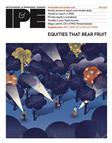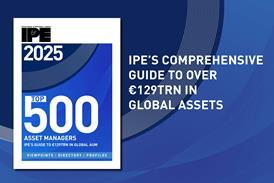A product that offers the better of bond or equity returns looks like the ideal investment, but till now convertibles have been somewhat overlooked by pension funds. In the past the size of the market was the main drawback, since any investment would be too small to make a significant impact on risk-adjusted returns and the cost of employing specialist managers and monitoring performance prohibitive. But with issuance increasing year on year, booming noticeably in 2001 against the background of lacklustre bond and equity markets, the market has reached a critical mass that makes it now worthy of consideration as a diversifier and additional source of return.
There is anecdotal evidence of pension funds across Europe making allocations of as much as 10% to convertibles, although a median level would probably be around 5%. Some large Swiss pension funds are known to be invested and German and Dutch funds including the former PVF fund are believed to have made allocations. With extremely low bond yields at the long end and funds increasingly interested in accessing corporate credits, convertibles are finally appearing on institutional radar screens. Fitting convertibles into the structure of the pension fund can be problematic if consultants strictly adhere to bond/equity demarcation. Swiss funds have made either a separate allocation or allotted money to convertibles as a sub-allocation of the bond portion of the fund. The increasing fascination with ‘alternatives’ may provide an opening to introduce convertibles, and this is a route that has apparently been used by some Dutch pension funds. As Katalin Tischauser, head of convertibles research at Goldman Sachs, comments: “Although not offering as many diversification benefits as, say hedge funds or private equity, being fundamentally not dissimilar from traditional products, selecting and assessing managers for convertible investments is easier.”
The simplest version of the product is a bond that may be converted into a fixed number of shares up until maturity. This implies a conversion price above which it would make sense to convert into shares and below which one should allow the bond to be redeemed. Whether the convertible provides equity-like or bond-like returns will depend largely on where the share price is trading, relative to this conversion price. Hence, in strong equity markets, a convertible will automatically behave more like a share and in weak markets like a bond. This asymmetry in returns is the main case for investing in convertibles as it is extremely difficult (no matter what one’s balanced manager might say) to replicate this return profile by dynamically adjusting bond and equity allocations.
There are various nuances to the basic convertible product, for example exchangeables, at the forefront of the flood of European issues, where a company issues a bond convertible into another company’s shares. Call and put features complicate the analysis – calls allow the issuer to call back the bond and force conversion, and puts provide a guaranteed exit level to the investor, at certain dates over the bond’s life. Resets, which became common in Japan in the mid 1990s, rebase the conversion ratio to reflect any fall in the share price, offering additional value to the investor. Contingent conversion makes conversion subject to the equity price remaining above a certain level for a certain time, and this structure offers tax advantages to US issuers. Notwithstanding these ‘bells and whistles’ the underlying principle remains the same, the convertible behaving more like a share as markets rise and assuming bond characteristics on the downside.
Not that bond-like performance means no downside risk. As with a corporate bond, an investor accepts the credit of the issuer. A plunging equity price could be symptomatic of difficulties at the corporate level that might affect its ability to repay the debt. In earlier times when the convertibles market was made up overwhelmingly of low grade mid cap names and thinly capitalised tech stocks, this downside credit sensitivity provided another reason to steer clear. But as blue chips have entered the market in droves, the quality of credit and market coverage has improved, so mitigating this risk.
Global analysis by Goldman Sachs and Fisch Asset Management demonstrates an improvement in risk-adjusted returns over a long time scale through the inclusion of convertibles into a mixed bond/equity portfolio. Ibbotson Associates have also produced supporting studies on the performance of the US convertibles markets from as far back as 1957 (Convertibles as an Asset Class; 1957-1992 and updates in 1997, 1998 and 1999) which have been published in the Journal of Fixed Income and as Goldman Sachs research.
Using benchmark indices as proxies for bond, equity and convertible investments, Goldman Sachs compared the returns on two portfolios, one containing 50:50 bonds and equities and the other introducing 20% convertibles. The volatility of the portfolio containing convertibles was matched to the other portfolio by adjusting the bond/equity ratio, so each had the same level of risk. Taking data from 1994 onwards, Goldman Sachs found improved returns in all markets from the 20% convertible portfolio, with increases of 42bps pa in Europe and 47bps pa in Japan and figures of +34bps and +69bps pa when compared against large and small cap US stocks. Narrowing the period under inspection to the last five years, the results improve to +97bps in Europe +93bps (large cap) and +125bps (small cap) in the US, +74bps pa in Japan and +338bps pa in Asia. Efficient frontier analysis, using historic risk, return and correlation data on the US markets for the period 1973-2001, yielded an expected 46bps pa additional return and potential for reducing risk by 5bps. The same analysis for Europe yielded an extra 52bps pa of return. Correspondingly, the EFA results are improved by shifting the starting date for the analysis to after the 1994 bond market dislocation (84bps in the US, +106bps in Europe) .
Perhaps the most telling performance statistics come from Japan, where convertible returns have remained positive and exceeded both bond and equity returns over the period. Broadly speaking, over the 1994 – 2001 period, convertibles demonstrated half to two-thirds the risk of equities globally. But whereas in Europe and versus large cap US stocks convertibles underperformed equities by a figure of 0.5-1.5%, convertibles outperformed US small caps, Japan and Asia by 4-7% pa.
Actual performance statistics for the hybrid International Convertible Expert Fund, managed by Fisch Asset Management in Zurich, show outperformance of 16.8% versus the MSCI World index over the period from end 1990 through to third quarter 2001, returning some 163.8%. Fisch estimate the fund’s sensitivity to equity prices at 60-70% on the upside and 30-40% on the downside, witness the performance figures from November 1999 to September 2001 which show a fall of 1.9% versus the S&P500 index down 24.2% over the period.
The continuous cycle of issue and redemption or conversion of convertibles means that the market is continually refreshed and the investor is repeatedly offered the opportunity to participate in new issues, which to be successfully placed must be offered at a discount to theoretical value. New convertible issues are typically sold within a space of three to four hours, reflecting ready demand and a strong consensus in the market as to the right price to bring an issue. According to Tischauser the average life of a convertible is some three to four years and so there must be annual issuance of a quarter to a third of the current market to keep it the same size. The rapid growth of the market in the last five years, at an annual rate in Europe and the US of 33-35% compounded, has created even more opportunities for extracting excess return.
T hat there is a persistent undervaluation in the convertibles market giving rise to excess returns is evidenced by the proliferation of convertible arbitrage funds. Their aim is to monetise the undervaluation by identifying and stripping out the underlying risks to retain a risk-free spread. The strategy has been one of the best and most consistently performing hedge fund strategies over the past seven years, with average annual returns of 11% and standard deviation of 4.80% (TASS Research). Market participants estimate that some 60-70% of outstanding issues are in the hands of convertible arbitrage funds and their current domination of this market should be seen as evidence of cheapness, not as a disincentive to invest. However, market stability could be at risk to any major hedge fund blow-up forcing unwinding of positions and creating a run on certain issues, particularly if aggravated by a funding squeeze.
UBS Warburg started recording global convertible data on 31 December 1993, and, if a benchmark convertible index series exists, this is probably it, to the extent that it forms the basis of research from other investment banks. UBS Warburg operates two headline Global and Global Focus indices plus various sub-indices. Constraints of a $100m minimum deal size and at least two market makers quoting 2 point bid-ask spread bring the global universe of 2,500 bonds with market cap of $500bn down to the 600 bonds with a $300bn market cap that make up the Global index. The Global Focus index contains only the most tradable £139bn of paper that could realistically function as a basket. Sub indices split the market by not only sector and geographical boundaries but also by type of convertible, for example, screening by credit quality and premium level. Some caveats have to be placed on data from the early years of operation as, pre-1995 the poor representation of many countries means that the market could not then be considered truly global.
Another index series boasting longevity is the Jeffries Active Convertible Index series, run by Jeffries International, the Swiss broker and asset manager, which runs from January 1993. Besides the main global index, Jeffries report regional and country sub-indices in various currency formats. The indices only contain the tradable issues, subject to market cap and dealing rules that vary from country to country. By recombining the regional indices, the global index is made up of 210 bonds in total, representing a market capitalisation of $150bn.
Otherwise, the French broker, Exane, caters for the French investor base by producing a French domestic index and a European convertible index. The Goldman Sachs Bloomberg index is readily obtainable but dates back only to 1998. It aims to reflect the liquid, investable part of the convertibles market. The Morgan Stanley Europe 75 index runs from 31st December 1998 and covers some 66% of European market capitalisation.
For European investors, convertibles provide access to a broad range of good quality corporate credits. The euro has spurred more and larger issues, with the result that some 60% of the European market is denominated in euros, 20% in US$ and the remainder in legacy currencies, sterling and Swiss francs. As Martin Haycock, head of convertible research at UBS Warburg relates: “the European market has doubled in size since the launch of the euro and deal sizes greater than E500m are the norm, with $1bn an average and jumbo’s of $5bn plus achievable”. Convertible paper amounting to E8bn and $6bn has been issued by France Telecom and Hutchison respectively in the last two years, outstripping what would have been possible in either the straight bond or equity markets.
According to Morgan Stanley research, investment grade quality issuers account for some 80% of the European market. Colum McCoole, head of convertible research at Morgan Stanley, regards the main challenges for pension funds to overcome as being belief in the sustainability of the market and breaking the link between transparency and liquidity. Morgan Stanley’s research highlights a turnover of $450bn in European convertibles in the first 11 months of last year versus the total market size of $130bn, despite trading in the market being primarily over-the-counter. A looming obstacle for the European market to surmount in the next two years is the £35bn of redemption, either by maturing or coming up to a put. For more than half of these issues, the share price needs to rise by 50% or more to make it worthwhile for investors to convert. In the telco sector, which makes up 24.6% of the European market, the situation is particularly acute, as some 80% of redeeming bonds are trading on a premium above 50%. Refinancing or restructuring of these issues will be a strong feature of the market in the next two years.
Fisch Asset Management’s diverse range of funds demonstrates one of the difficulties involved in appointing a convertibles manager. Within their SFr1bn (E680m) of funds under management, it operates bond-like funds, three hybrid strategies, an equity-sensitive Japanese fund and an opportunistic fund. Setting a convertible mandate involves not only deciding geographical coverage, but also defining the type of convertibles that can be held, possibly limiting by minimum and maximum premium levels, or with reference to the convertibles delta (equity sensitivity). However, as McCoole comments: “arbitrarily restricting a manager to convertibles within a certain range could cause problems if the whole market moves in one direction, leaving only a small number of permissible names.” In McCoole’s opinion most outright managers construct their funds to target an average delta in the range of 30-45%. But, with some 70% of bonds within 10% of the bond floor and the weighted average delta at 30%, new at-the-money issues are needed to allow managers greater flexibility in achieving their target equity sensitivity.
The roll call of European outright investors in convertibles, as opposed to arbitrage players, has changed little over the last decade. The Swiss managers, a dominant force in the market in the early 1990s still hold probably 10-15% of the market and the major names include Lombard Odier, Pictet, Bank Julius Baer, UBS Asset Management and Credit Suisse Asset Management, as well as the specialist house Fisch. Many French fund managers, including AGF, Sogepost, Paribas and Soc Gen operate domestic mandates alongside pan-European and global funds. In Germany DWS, Deutsche Asset Management and DeKA are active, plus some of the Landesbanks. Manager selection must take into account, not only specific product experience, but also the track record of the house in equity and credit analysis, and the ability to manage risk in a market with variable liquidity and concentrated risk factors.








No comments yet